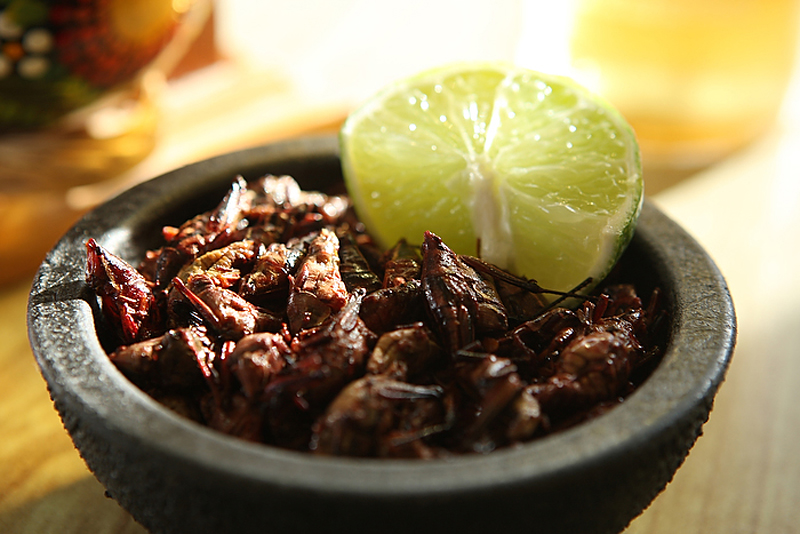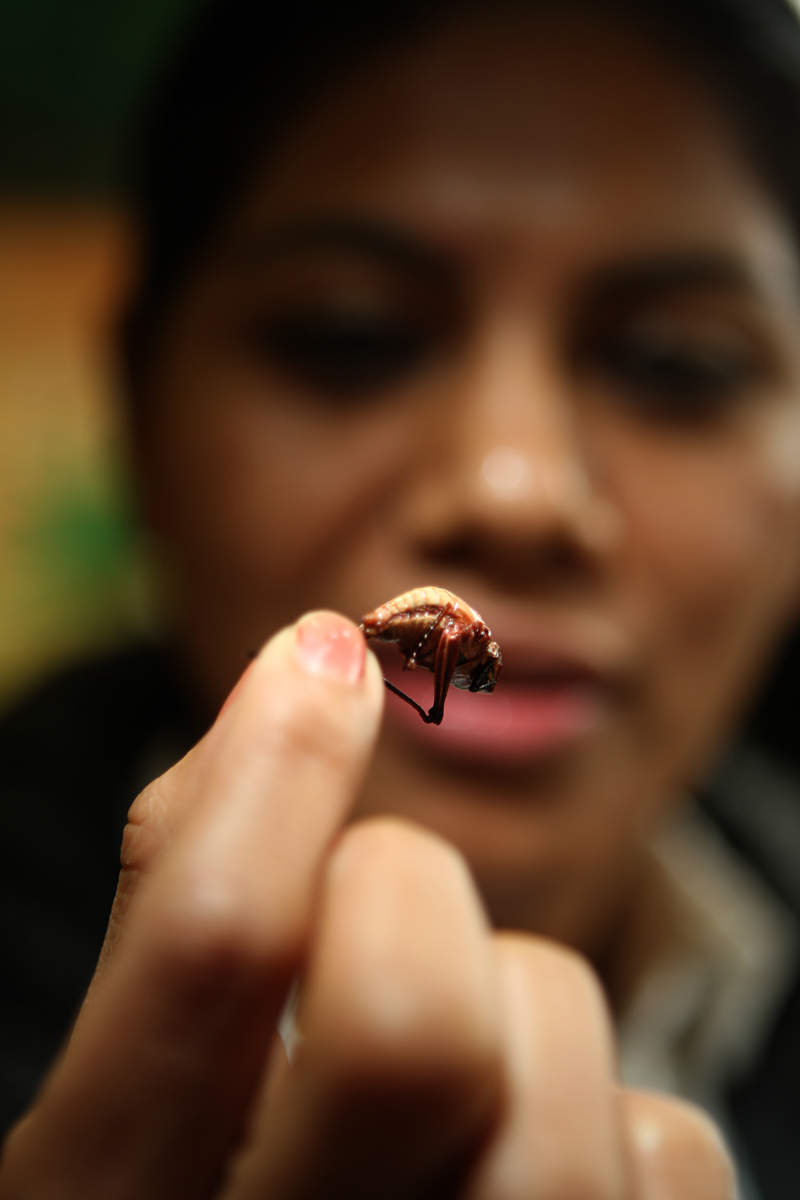El Tio’s menu is monumental, about the size of a small pillowcase. Like an IHOP menu redone with chorizo and string cheese, its laminated pages pop with saturated images of white-corn tortillas contorted into every imaginable pose, molded mounds of yellow rice, pools of bluish mole negro, and thin pennants of ruddy beef bruised by the grill. But even among so many colorful choices, the picture of a shallow, crimped-edged pot teeming with toasted grasshoppers stands out.
Despite the predictions of insect proselytizers, bugs still haven’t landed in the American mainstream. Grasshoppers (chapulines), locusts, and their kin are high in protein, low in fat, impressively gentle on the planet, and almost impossible to find in stateside restaurants. On Capitol Hill, the fiesta-minded Poquitos offers chapulines as a bar snack, but they’re meant mostly as a conversation starter, whereas for the southern Mexicans who gather at El Tio—the Burien storefront formerly known as El Sabor de Oaxaca—the grasshoppers are a familiar finger food to nosh on while talking about the day.
If you’re not familiar with chapulines, they taste uncannily like sunflower seeds. Indeed, the resemblance is so intense that I scoured the Web for pictures of Latin ballplayers gnawing chapulines in the dugout. (No dice, but I learned the grasshoppers are a popular spectator snack.) Fried with chile and spritzed with plenty of lime juice, the grasshoppers have a salty, sour crunch and slick oiliness that begs for a swig of Modelo. Unfortunately, there isn’t any beer at El Tio, although a liquor-license application is posted near the front door. “Proxima semana,” our server promised. In the meantime, there’s horchata and Mexican Coke.
El Tio imports its chapulines from Oaxaca. In fact, the restaurant imports lots of ingredients from Oaxaca. If you have any qualms about being told “No” when asking “So, do you make the (blank) here?”, it’s probably best to keep your lips zipped. But the sourcing situation is a good reminder that eaters can have authentic or they can have handcrafted, but rarely can they have both. El Tio is wonderfully true to a Oaxacan yeoman aesthetic, and the results are pretty delicious.
Perhaps the best dish at El Tio—and the second-best reason to look forward to the state liquor control board’s approval of the restaurant’s beer permit—is the tlayuda, a roulette wheel of parchment-thin grilled tortilla smeared with a lard-enhanced black-bean paste and topped with shredded lettuce, tomato wedges, slim avocado slices, snaking threads of rubbery Oaxacan cheese, and a plump, blistered jalapeño. Commonly called a Mexican pizza, the tlayuda is wilder than the standard Italian pie: The edges of its brittle base tostada coil and curl away from the plate, which it overhangs by a good two inches. A knife’s handy for splitting up the tlayuda, but no utensils are needed to eat it.
El Tio’s tlayuda originates in Oaxaca, where the masa is pressed, stretched, baked over hot coals, and aged for a week in a palm-leaf basket, a step apparently essential to securing the dry/moist consistency that tlayuda partisans crave. The subtly smoky tortilla is then sent north for finishing: In addition to fresh vegetables, El Tio applies a selection of meats to its regrilled tlayudas, including a crumbled chorizo with an appealingly fatty punch.
It’s up to the customer to add hot sauce. There’s Tapatio on the table, and a thin housemade sauce flavored with a Christmas confetti of red and green chiles and spices. Or, better yet, request a tlayuda with a thin coat of mole, dark and weighty as swamp mud. Eaters who know anything about Oaxacan cuisine understand that the region’s revered for its moles. There are seven distinct varieties of the chile-pepper sauce, and El Tio serves three of them. The mole negro gets the most screen time: It’s draped over squishy enchiladas, liberally ladled on steak plates, and painted atop molotes—stiff croquettes of mashed potato and pork secreted in masa. In small doses, the gently bitter mole is plummy and nutty with a hint of cloves, but I found its dark chocolate richness becomes overwhelming when served by the cupful. Still, if your personal Candy Land is landscaped with mole-filled canals, you may have no complaint about El Tio’s version.
On the opposite end of the mole spectrum, mole verde is a raging fresh stew that draws its distinctive green color from tomatillos. Unlike its counterparts made with dried herbs, mole verde is nearly translucent on the spoon. The lightness and somewhat belabored brightness of El Tio’s oniony verde (another good target for hot-saucing) reminded me of Campbell’s condensed cream-of-broccoli soup. And I mean that as a compliment.
Like the verde, the mole amarillo is poured over the back quarter of a chicken, its dark, salty meat softened by the surrounding stew. But while the mild verde has the warm, sloppy character of orphanage gruel, El Tio’s orange-hued amarillo benefits from a distinctly Caribbean tinge. The mole tastes of allspice and peppercorns, and is reminiscent of a West Indies pepperpot soup. Perhaps the most contentious of the seven formalized moles, amarillos are sometimes thick and sometimes thin. El Tio’s is fairly sheer, but the seasoning has a complexity missing from the other two moles.
Should you find yourself energetically parsing the herbs in your mole, it’s likely time to order another round of chapulines. El Tio isn’t the kind of restaurant that lends itself to humorless culinary scrutiny—it’s designed to sell excellent $12 tlayudas to families with herds of young children; there are two different signs asking patrons to “cuide a sus hijos.” Although the restaurant was largely empty both times I dined there, it’s set up to accommodate noisy, messy eaters of all ages. The floor is covered in square white tiles, and the cinderblock walls—painted a cheery yellow—are hung with Mexican prints and televisions tuned to variety shows. Other than the blue-vinyl booths and a few freestanding tables, the only furnishings are a gumball machine and a sandwich board advertising the day’s specials.
With such an extensive menu, though, many customers never consult the specials list. They’re understandably content with the string-cheesy quesadillas, terrific empanadas crowded with funky corn smut, and pliant tamales with damp walls of masa. El Tio also sells dessert rolls, with pan de muerto available for the Day of the Dead next week. Are they made in-house? It makes no difference. What matters is that they’re served with steaming mugs of hot chocolate, same as in Oaxaca.
PRICE GUIDEChapulines $4Tlayuda $11.95Molotes $7.50Mole con pollo $8.75Empanada de huitlacoche $9.25Hot chocolate $3.50









